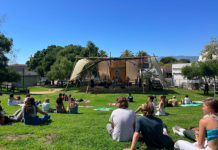Xiaotong Zhou
Staff Writer
After a year of preparation, Amazon opened the world’s first checkout-free store, Amazon Go, in Seattle on Monday, Jan. 22. Customers in the store can buy “ready-to-eat breakfast, lunch, dinner, and snack options,” as well as “grocery essentials” and “chef-designed Amazon Meal Kits.”
Unlike traditional brick-and-mortar grocery stores or supermarkets, such as Walmart and Costco, Amazon Go carries out its promise to provide a no checkout, no lines shopping experience.
Customers scan a unique QR code on the Amazon Go app upon entering the store, grab their desired products, and walk out. The charge goes directly to each customer’s linked Amazon account. Amazon Go’s unique retail model is built upon the use of proprietary technology, including hundreds of cameras and sensors, to disentangle people from waiting in lines.
The core technology Amazon Go uses is called Amazon Rekognition, a program for deep-learning based image recognition. Amazon Rekognition “identif[ies] objects, people, text, scenes, and activities, as well as detect[s] any inappropriate content,” while also providing “highly accurate facial analysis and facial recognition” of the customer.
When the customer taps his or her phone near the sensors upon entering, the surveillance system powered by Amazon Rekognition identifies the customer. The image is then uploaded to the cloud, where it is shared with other devices to track the customer’s activity.
According to the company’s online FAQs, Amazon Go employs “the same types of technologies used in self-driving cars: computer vision, sensor fusion, and deep learning.” The “Just Walk Out Technology” keeps track on the products in the virtual cart by detecting what and when products are taken or returned to shelves.
“The majority of sensing is from above,” Dilip Kumar, Vice President of Technology for Amazon G, said in an interview with The Washington Post. “Cameras figure out which interactions you have with the shelves. Computer vision figures out which items are taken. Machine-learning algorithms also determine which item it is.”
Amazon also uses technology to bring together data from different sensors across the store to increase the accuracy of the results. Amazon’s patent filing claims “in some implementations, data from other input devices may be used to assist in determining the identity of items picked and/or placed in inventory locations.”
Load sensors are in place to determine when more than one person grabs products off of the same shelf at the same time. The gravity and load sensors calculate the weight on the shelf to determine how many products are taken or returned and an infrared sensor records it.
Besides cameras and sensors, lots of microphones are found in Amazon Go. Microphones track where customers are by detecting the noises they make and analyzing the time difference between the audio signals received by each microphone. This is exactly the same technology that Amazon uses in its Alexa voice-control system.
By analyzing data collected from multitude of monitoring systems in the store, Amazon can better understand customers’ preferences in order to adjust products to the prime locations on the shelves.
Regardless, the cashier-free store provides a new lifestyle — the merging of state-of-the-art technology and traditional shopping. The long lines on the opening day have already shown its popularity, increasing Amazon’s confidence to expand its market share of grocery stores, as well as applying its technology into other forms of stores.

















